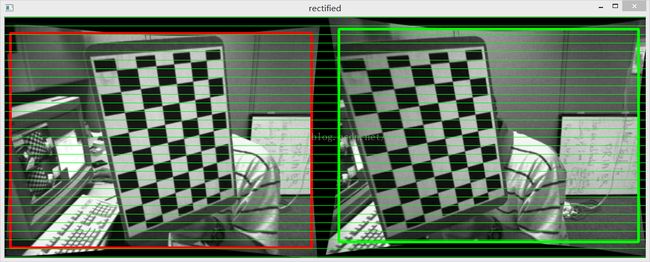OPENCV3.0 双目立体标定
这里是在上一篇单目标定的基础上拓展来的进行双目标定的程序。
在这个程序里面,默认是先对两个摄像头分别进行了单目标定的,也就是说相机的内参数和畸变向量是知道了的。
所以在进行标定的时候,参数选择的是CALIB_USE_INTRINSIC_GUESS。
此程序依然是使用系统自带的标定的图片,其路径在opencv的安装目录下:opencv\sources\samples\data。
本程序最终的输出图像为
上图就是左右相机的图像经过行对准之后的结果。
具体的代码如下:
// stereoCalibration.cpp : 定义控制台应用程序的入口点。
//
//在进行双目摄像头的标定之前,最好事先分别对两个摄像头进行单目视觉的标定
//分别确定两个摄像头的内参矩阵,然后再开始进行双目摄像头的标定
//在此例程中是先对两个摄像头进行单独标定(见上一篇单目标定文章),然后在进行立体标定
#include "stdafx.h"
#include
#include
#include "cv.h"
#include
#include
using namespace std;
using namespace cv;
const int imageWidth = 640; //摄像头的分辨率
const int imageHeight = 480;
const int boardWidth = 9; //横向的角点数目
const int boardHeight = 6; //纵向的角点数据
const int boardCorner = boardWidth * boardHeight; //总的角点数据
const int frameNumber = 13; //相机标定时需要采用的图像帧数
const int squareSize = 20; //标定板黑白格子的大小 单位mm
const Size boardSize = Size(boardWidth, boardHeight); //
Size imageSize = Size(imageWidth, imageHeight);
Mat R, T, E, F; //R 旋转矢量 T平移矢量 E本征矩阵 F基础矩阵
vector rvecs; //旋转向量
vector tvecs; //平移向量
vector> imagePointL; //左边摄像机所有照片角点的坐标集合
vector> imagePointR; //右边摄像机所有照片角点的坐标集合
vector> objRealPoint; //各副图像的角点的实际物理坐标集合
vector cornerL; //左边摄像机某一照片角点坐标集合
vector cornerR; //右边摄像机某一照片角点坐标集合
Mat rgbImageL, grayImageL;
Mat rgbImageR, grayImageR;
Mat Rl, Rr, Pl, Pr, Q; //校正旋转矩阵R,投影矩阵P 重投影矩阵Q (下面有具体的含义解释)
Mat mapLx, mapLy, mapRx, mapRy; //映射表
Rect validROIL, validROIR; //图像校正之后,会对图像进行裁剪,这里的validROI就是指裁剪之后的区域
/*
事先标定好的左相机的内参矩阵
fx 0 cx
0 fy cy
0 0 1
*/
Mat cameraMatrixL = (Mat_(3, 3) << 532.782, 0, 532.904,
0, 342.505, 233.876,
0, 0, 1);
Mat distCoeffL = (Mat_(5, 1) << -0.28095, 0.0255745, 0.00122226, -0.000137736, 0.162946);
/*
事先标定好的右相机的内参矩阵
fx 0 cx
0 fy cy
0 0 1
*/
Mat cameraMatrixR = (Mat_(3, 3) << 532.782, 0, 532.904,
0, 342.505, 233.876,
0, 0, 1);
Mat distCoeffR = (Mat_(5, 1) << -0.28095, 0.0255745, 0.00122226, -0.000137736, 0.162946);
/*计算标定板上模块的实际物理坐标*/
void calRealPoint(vector>& obj, int boardwidth, int boardheight, int imgNumber, int squaresize)
{
// Mat imgpoint(boardheight, boardwidth, CV_32FC3,Scalar(0,0,0));
vector imgpoint;
for (int rowIndex = 0; rowIndex < boardheight; rowIndex++)
{
for (int colIndex = 0; colIndex < boardwidth; colIndex++)
{
// imgpoint.at(rowIndex, colIndex) = Vec3f(rowIndex * squaresize, colIndex*squaresize, 0);
imgpoint.push_back(Point3f(rowIndex * squaresize, colIndex * squaresize, 0));
}
}
for (int imgIndex = 0; imgIndex < imgNumber; imgIndex++)
{
obj.push_back(imgpoint);
}
}
void outputCameraParam(void)
{
/*保存数据*/
/*输出数据*/
FileStorage fs("intrinsics.yml", FileStorage::WRITE);
if (fs.isOpened())
{
fs << "cameraMatrixL" << cameraMatrixL << "cameraDistcoeffL" << distCoeffL <<"cameraMatrixR" << cameraMatrixR << "cameraDistcoeffR" << distCoeffR;
fs.release();
cout << "cameraMatrixL=:" << cameraMatrixL < 